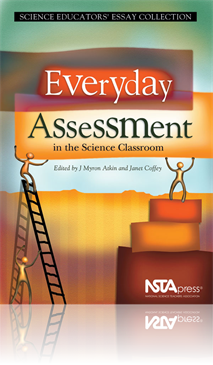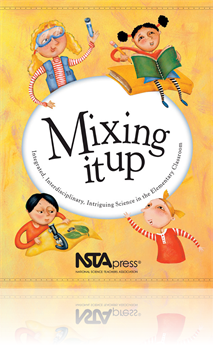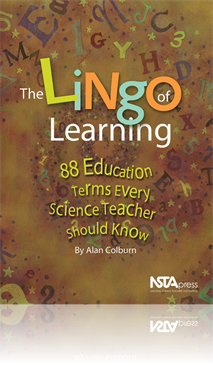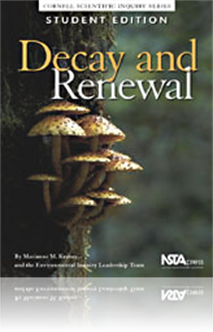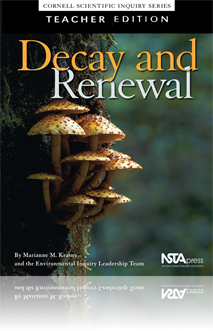All Resources
Book Chapter
Teaming is a method of grouping students so they share the same set of teachers for their core subject areas—science, math, language arts, social studies, and sometimes physical education and health. Most often, teams are created when an entire gr...
Book Chapter
Our lives are ones of uncertainty and surprise, yin and yang existences. Some things we can control and others we are powerless to command, even with the best intentions. Teachers are not exempt from emergencies, jury duty, and illness. Luckily, m...
Book Chapter
Front-page articles in science and education periodicals and journals give voice to the growing concern that scores on nationwide science exams have either declined or, at best, have had a minute increase even after several years of pushing for bette...
Book Chapter
Whether your assigned classroom is for science labs or there is a specific lab area shared among several teachers, you need to set up properly for group experiments and other hands-on activities. There are several ways to set up lab groups in various...
Book Chapter
Cooperative Learning and Assessment
Cooperative learning in its simplest sense is two or more students working together on an assignment. In an expanded definition, cooperative learning becomes an opportunity for students to interact with one another intellectually and socially under ...
Book Chapter
Writing, as we all know, is an integral part of any discipline. And, because of the important role that writing up lab reports and research plays in the field of science, you must help your students work on writing throughout the year. This chapter...
Book Chapter
Adapting Labs and Troubleshooting
A great deal of information is available on how children learn—brain research, multiple intelligence aspects, concrete versus abstract thinking, environmental stimuli, and so on—but one key feature can be gleaned from all of the studies, and that...
Book Chapter
One common misconception in the middle school science classroom is that students magically will know how to do many of the seemingly easy tasks teachers assign. In reality, even the simple direction of using written resources to gain background info...
Book Chapter
One of the most challenging activities in the middle school science lab is taking measurements. A simple ruler can send students into a questioning mob around a teacher, not unlike a shark-feeding frenzy. Student activities that require using and r...
Book Chapter
This section includes resources that any new teacher would want to have at their fingertips. It offers reproducible lists, quizzes, and forms. These resources will assist in making the first year of teaching a smooth and successful one....
Book Chapter
This section offers practical resources that will be quite valuable during those first few months of teaching middle school science. Here you will find recipes that include salt crystals, culture medium, fun putty, and the ever-popular "oobleck". T...
Book Chapter
The Importance of Everyday Assessment
Assessment for learning is set in the context of conflicts and synergies with the other purposes of assessments. The core ideas are that it is characterized by the day-to-day use of evidence to guide students’ learning and that everyday practice mu...
Book Chapter
As a context for thinking about the claims made in this book, some of the circumstances that have influenced the demand for and character of assessment in general are noted. The argument is then made that the substantial lack of coherence in today’...
Book Chapter
Learning Through Assessment: Assessment for Learning in the Science Classroom
This chapter presents an extended example from a middle school science classroom of what assessment that supports learning looks like. In the example, the teacher models assessment for learning by talking about learning with her students; showing sam...
Book Chapter
Examining student work is an essential aspect of teaching, yet it is easy to miss opportunities to learn about how students are interpreting—or misinterpreting—the lessons we present to them. In this chapter the author shares insights concerning ...
Book Chapter
This chapter provides an overview of frameworks that teachers can use to conduct assessments of students’ engagement in scientific inquiry. The author examines two factors that are central to such assessment. One factor is the design of classroom l...
Book Chapter
Using Questioning to Assess and Foster Student Thinking
Questioning can be used to probe for understanding, to initiate inquiry, and to promote development of understanding. The results from questioning, listening, and assessment also can be used by teachers to promote their own growth as professionals. T...
Book Chapter
Involving Students in Assessment
While much of the responsibility for classroom assessment lies with teachers, students also play an important role in meaningful assessment activity. Bringing students into the assessment process is a critical dimension of facilitating student learni...
Book Chapter
Reporting Progress to Parents and Others: Beyond Grades
As science education moves increasingly in the direction of teaching to standards, teachers call for classroom assessment techniques that provide a richer source of “rigorous and wise diagnostic information.” Student-to-student comparisons and si...
Book Chapter
Working with Teachers in Assessment-Related Professional Development
Professional development related to everyday classroom interactions can require a shift in the teacher’s priorities in the classroom from a focus on managing activity and behavior to a mind-set of managing learning opportunities. This essay looks c...
Book Chapter
Reconsidering Large-Scale Assessment to Heighten Its Relevance to Learning
In contrast to classroom assessments that can provide immediate feedback in the context of ongoing instruction, large-scale assessments are necessarily broader survey instruments, administered once-per-year and standardized to ensure comparability ac...
Book Chapter
Although this terrific interdisciplinary, cooperative-learning science experience began primarily as a language arts assignment to compare the leadership skills of two fascinating men, it grew to encompass an exploration of ice's properties and taugh...
Book Chapter
At the beginning of the 21st century, education seems dominated by talk about educational outcomes and their assessment. This chapter serves to demystify these topics. This free selection includes the Preface, Table of Contents, an About the Author p...
Book Chapter
This chapter highlights documents such as the National Science Education Standards that were designed to be achievable by all students, no matter their background or characteristics. Project 2061: Science for all Americans and Project 2061: Benchmark...
Book Chapter
The scientific method not only describes inaccurately how science works, but also distorts the meaning of words such as "theory" and "law." A theory, in science, is a widely applicable explanation. A law is a generalization or pattern derived directl...
Book Chapter
General Instructional Approaches
Advocates of STS—science-technology-society—approaches believe that the science curriculum should pay special attention to science-based social issues. They envision K-12 science classes being best when focusing on the boundary between science an...
Book Chapter
This chapter presents several models of instruction from cooperative learning to inquiry-based instruction. It concludes with the 5E Model of instruction, pioneered by the Biological Sciences Curriculum Study (BSCS 1993....
Book Chapter
Pedagogy means teaching and teaching is what teachers do. It's a fancy word with a simple meaning. In reality, the distinction between pedagogy and curriculum can be a bit difficult because what is taught and how it is taught are deeply intertwined. ...
Book Chapter
Assessment, broadly defined, means information gathering. Grading (or evaluating) students is certainly one type of assessment. Tests, portfolios, and lab practicals are all assessment devices. However, teachers assess students in other ways. When te...
Book Chapter
The Association for Supervision and Curriculum Development (2002) defines “diversity” in this way: “In education, discussions about diversity involve recognizing a variety of student needs including those of ethnicity, language, socioeconomic c...
Book Chapter
As is the case with the other chapters in this book, each entry in this chapter should stand on its own. However, more than in other chapters, the ideas presented in this chapter tend to build on each other. Ideas that began with Piaget were later ch...
Book Chapter
This chapter presents research concepts featuring qualitative, quantitative, and action research. Qualitative research generally involves a researcher combining observation, interview, and analysis of various documents. Quantitative research represen...
Book Chapter
This chapter discusses teacher education from the preservice teachers—the period when they are learning to teach as undergraduate or graduate students—to induction—the period when they are making the transition from student teacher to an experi...
Book Chapter
This section offers insights about the uniqueness of teaching in a two-year college. Hello! Is Anybody Out There? explores one commonality that exists among many two-year colleges—isolation, including the social, financial, and political isolation ...
Book Chapter
Natural Forces of Decay and Renewal
Through biodegradation, dead plants and animals get broken down and so do the waste products they produce while living. For plants, these waste products include dead leaves and the remnants of seeds and blossoms. For animals, wastes include excrement...
Book Chapter
This section covers understanding biodegradation, including biodegradation protocols providing specific instruction on research. The section also provides techniques in interactive research for developing experiments and field studies using the proto...
Book Chapter
This section outlines possible assessment criteria for student research, as well as example assessment rubrics for posters and written reports. Engaging in peer review provides both opportunities and challenges for assessment. Some of the assessment ...
Book Chapter
Decay and Renewal presents an inquiry-based approach to studying biodegradation, the assortment of biological processes that cause organic matter to decay. Biodegradation occurs in nature and in human-engineered systems to prevent or clean up envir...
Book Chapter
Biodegradation Protocols: Introduction to Research
This section presents 14 research protocols. Using one or more of these protocols, students will be able to design and carry out their own experiments. Students will also experience some of the ways in which scientists work together to discuss ideas,...
Book Chapter
Interactive Research: Experiments and Field Studies
This section provides advice to help students choose from a wide range of ideas for research projects. It also provides a series of worksheets designed to guide progress through the various steps of designing and carrying out an experiment, presentin...




